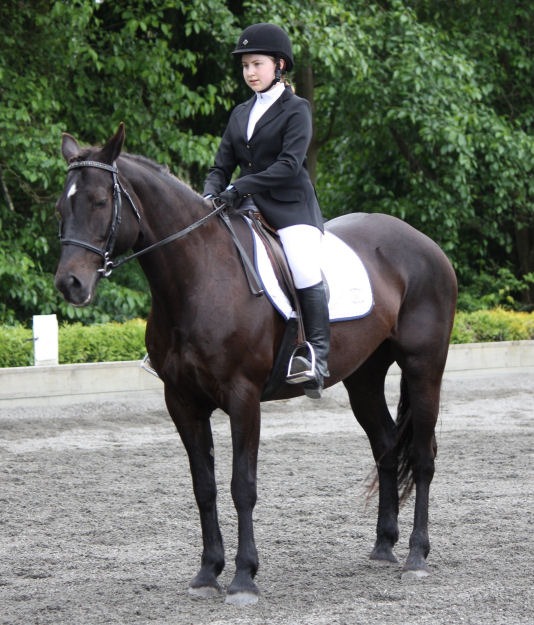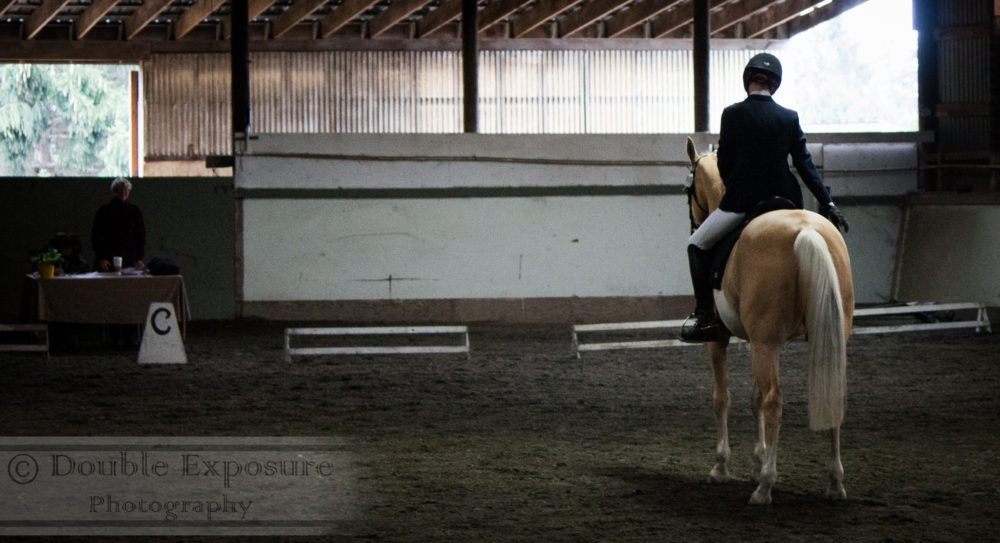Riding Level 4: Transitions
Before you read this post, review the Level 3 post on the Half Halt. You will want all this information to be second nature by now, as we look at the next Level 4 checklist item:
5. Effectiveness and use of Aids. Transitions. Halt. Salute
At this level, we will not only be looking to see that your horse makes the transitions accurately, but we want to see that your legs, hands, and seat are giving the appropriate cues, supplemented only as necessary by whip or spur. And yes, we can see things as subtle as you sitting deeper in your saddle, shifting your weight, or bracing the hand: not by the movement of your body, but by the reaction of your horse.
Riding Transitions
Some of the things we will look for in transitions are:
- Accuracy. Does the horse change gait or pace at the indicated letter? Are circles round, and of the right size? Are turns down the centre line or across the school straight with crisp corners?
- Connection. Does connection through the hands and seat remain constant through the transition? Is the horse connected from hind end to fore from one gait to the next, or does he become hollow and above the bit?
- Forward movement. Even in downward transitions, the feeling should be of moving forward to the new gate. A horse that moves forward to halt stops with his hind end well underneath him, pelvis slightly tucked, ready to move forward or backward as asked. A horse that doesn't move forward putters into the halt, dragging the hind legs to catch up with the fore.
- Suppleness and Willingness. Is the horse soft and supple or are there signs of tension? Tension and resistance can often be seen in the jaw, the poll, the shape of the neck, stiffness in the back, or tail-wringing or tail-clamping. These can all be signs of pain rather than just resistance. But if the horse goes well within the gaits and tension only occurs during transitions, it may indicate that the rider is offering inconsistent or contradictory cues.
Halt & Salute
Dressage tests traditionally end with a ride down the centre line ending in a halt, followed by a salute, often at 'X', but sometimes at 'G', in front of the judge (who sits at 'C'). To perform a salute, put your reins in your left hand, drop your right hand beside your leg, and dip your head. While this action seems simple, the halt itself is not.
Elements of a good halt
- At the halt the horse should be square in front; that is the front feet are absolutely parallel.
- One hind leg may be slightly ahead of the other, but the distance should be small.
- The horse should be straight on the centre line, so the oberver at 'C' cannot see the hindquarters.
- The horse should be waiting patiently in an engaged frame, without tossing the head, rooting for the reins or fidgetting.
How to nail your halt

- Make your turn down the centreline precisely at 'A'. If you are early or late you will need to drift diagonally toward 'C' and may still be crooked when you halt.
- Plan backward to 'X'. You are allowed 3 or 4 walk steps before the halt, so visualize the spot between 'L' and 'X' at which you will need to transition to walk in order to halt cleanly at 'X'. This length will vary from horse to horse, so be sure to know your horse's typical stride.
- As mentioned above, think 'forward' to halt. Support your horse with your legs as you slow to walk, then halt. This will keep the hind end engaged and help the horse stop her forward motion with the haunches well beneath her, ready to move forward again.
- Keep the horse straight between your aids. Your legs and hands form the straight chute your horse must stay in. If your aids are uneven, your horse will be crooked.
- Count to at least three during the halt before releasing the horse to go forward. Practise doing this at various points in the ring while you school so your horse knows he must wait till you give the go-ahead.
Once you have completed your halt and salute, walk forward on a relatively loose rein. Thank the judge/examiner as you ride past, give your horse a pat, and smile because your test is over!
Thank you to Double Exposure Photography for the use of their pictures!
Upcoming Classes
NEW! Ongoing Mounted Combat Skills
Beginning in February, weekly Mounted Combat Skills has been added to the classes you can attend with regular tuition. These 2-hour sessions focus on the weapons skills needed to progress from Green to Blue Spur. Regular tuition includes classes taken entirely from the ground (no riding skills necessary); a $50/month surcharge applies for those students with riding skills who wish to take part in the mounted section.
Sundays noon – 2pm
cost: basic tuition + $50/mo for horse use
instructor: Jennifer Landels
Beginner Riding & Horsemanship
If you’ve never been on a horse, or if it’s been a long time, here’s the place to start. When you arrive at the barn at 11am, you’ll begin with a horsemanship lesson, familiarizing yourself with the horses and their tack, as well as how to groom, handle and tack them up. Then you will have a riding lesson, working through the requirements of Riding Level 1 — the prerequisite to most of the fun stuff we do on horseback!
Sundays 11am – 1pm
22 January – 5 March *note: no class 19 February
12 March – 16 April
cost: $300 + gst for 6 classes
instructor: Stephanie Laversin
Register here, or bundle with Mounted Combat Fundamentals and save $26.
Riding & Horsemanship Level 2
This course is intended for riders who have taken classes through the program and are comfortable tacking up their own horses. Riders should arrive at 9:30am, to tack up and warm up their horses before starting their riding lessons at 10am, followed by Horsemanship Level 2 or 3 lessons at 11am.
Sundays 11am – 1pm
22 January – 5 March *note: no class 19 February
12 March – 16 April
cost: $300 + gst for 6 classes
instructor: Stephanie Laversin
Register here, or bundle with Mounted Combat Fundamentals and save $26.
